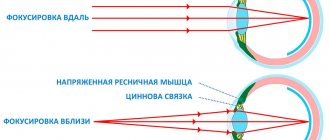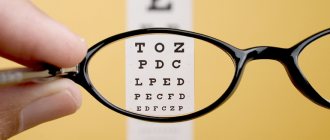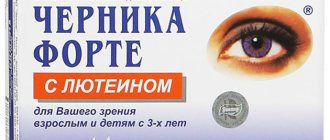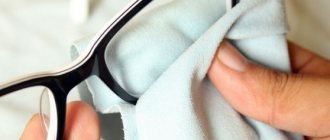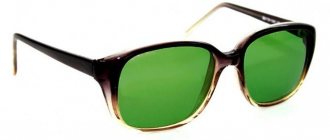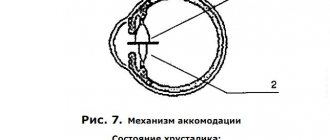Spasm of accommodation is a vision pathology, which is nicknamed “tired eyes syndrome” . This is false myopia, which is more typical for childhood. Adults are also susceptible to the development of this pathology as a result of prolonged visual stress (reading, constant work at the computer, embroidery, jewelry work, etc.).
Prolonged visual strain contributes to “fatigue” of the ciliary muscle, as a result, the eye ceases to perceive changes in focal length. This disease is the result of visual fatigue, as a result of which a person begins to have difficulty seeing objects at a distance.
Fortunately, the process is reversible, which is why the disease is known as false myopia. However, if you postpone a visit to the doctor during a spasm and neglect treatment, then myopia can become real.
The effectiveness of relieving accommodation spasms with drops
Medication is the most effective method of eliminating spasm of accommodation. Eye drops are prescribed by an ophthalmologist after a comprehensive examination of the patient’s visual system.
They help relax the ciliary muscle of the eye. Treatment is carried out in courses, the duration of which depends not only on the severity of the pathological condition, but also on the medicine itself.
Along with drops that relax the ciliary muscle, medications with a moisturizing effect are prescribed to help eliminate the accompanying signs of spasm - hyperemia, dryness and asthenopia.
Eye drops are effective in treating spasm of accommodation. They allow you to improve your condition, but only for a certain time. The spasm of accommodation may return to a more severe degree than previously diagnosed.
Therefore, an integrated approach to treatment is recommended. Only a combination of several methods guarantees a prolonged result, without the disease returning.
Treatment methods for spasms of accommodation (Part 2)
Description
DRUG TREATMENT OF ACCOMMODATION SPASMS
For a long time, attempts have been made to treat accommodation spasms using pharmacological agents. Two directions for this treatment have emerged.
Long-term and widely used long-term atropinization relieves spasm of accommodation only for the duration of atropinization, which was known back in the 19th century. It should be noted that in some cases atropinization has a positive effect. R. S. Zilberman (1966), using quite extensive material, showed that spasms of accommodation after atropinization do not recur for approximately 30%
cases. However, it must be emphasized that R. S. Zilberman observed self-healing of accommodation spasms in younger schoolchildren (without any treatment) in almost the same percentage of cases.
If the spasm of accommodation is not very persistent, then after paralysis of the ciliary muscle as a result of atropinization, especially long-term or fractional, it may not occur.
The second direction of drug treatment for spasms of accommodation is the prescription of miotics. In this case, they proceed from the fact that during spasm of the ciliary muscle, accommodation is difficult, and they strive to enhance muscle contraction with the help of miotics. So far this path has not justified itself. However, over the past 10 years in many countries, especially in Japan, specialists are again intensively engaged in drug treatment of spasms of accommodation.
The search for mydriatics, the most suitable for this purpose, led to the use of drugs such as midrin. This is tropical acid-N-ethyl-N (picolil) amid (Mydrin M). All authors reporting positive results from its use prescribe it according to 1
a drop in both eyes at night.
Some justification for prescribing mydriatics at night can be provided by the results of a skiascopic study of young children during physiological sleep (Berggren, Walinder, 1969). During sleep, refraction increases by at least 3.0-4.0D
.
The pupil is constricted. Thus, Yamaji et al. (1964) 92
students found before treatment visual acuity from
0.3
to
0.9
with an average myopia of
1.0D
.
After 3
months of using Midrin, visual acuity was from
0.9
to
1.2
and refraction was from myopia of
0.5D
to emmetropia.
Visual acuity increased in 82%
, myopia decreased in
70%
of children. Tasapo (1964) showed that midrin is effective in both the diagnosis and treatment of spasms of accommodation.
Furuta and Ischikawa believe that pseudomyopia is curable in 82%
children, the use of midrin gives improvement.
Kansai et al (1965), using
midrin M
114 1
month that visual acuity increased significantly in
58
eyes, slightly increased in
43
and remained unchanged in
13
eyes.
After 1
year of treatment, visual acuity increased in
70%
of children.
Mine et al (1965), using midrin, after 1
month noted a noticeable increase in visual acuity in
38
eyes, slight improvement in
43 eyes
, and no improvement in
13
eyes.
Rouher and Sole (1965) believe that the treatment of myopia should consist of daily use of weak mydriatics (at night) and vitamins: for 14
days in the evening
2-3
drops of neosynephrine (mesatone), then
10
days vitamins E and P with a dosage according to age.
Duration of treatment is 2-3
years.
Abraham (1966) in a review of the literature on cycloplegics reported treatment 136
eyes with the tropicamide mentioned above.
He found that this cycloplegic acts for 3
hours, its moderate effect lasts for 24 hours.
In 1968, Yamaji noted that the treatment of pseudomyopia with midrin is long-term (up to 57
months), refraction improves; in all cases, no side effects from midrin were noted.
In 1969, Noaka and Oae published the results of using cyclogyl at night (1%
cyclopentolate chloride) for the same purpose.
In 40
patients aged
7
to
18
years, in
62.9%
of cases, visual acuity increased on average from
0.44
to
0.59
, the degree of myopia decreased from -
0.92 D to
-
0.55 D.
Yamaji and Nakahuata (1970) reported treatment for 6 months with midrin (at night) and pilocarpine (in the morning). 50
children.
Visual acuity increased in 90.8%
, the degree of myopia decreased in
91.7%
of cases.
Characteristics of treatment results based on the average refraction value: before treatment - 0.59 D
;
at the end of 3rd
month of treatment -
0.0076 D
;
at the end the 6th
month
+0.23 D
;
3
months after the end of treatment
+0.15 D )
;
months after treatment - 0.088 D. However, after the end of treatment, the authors observed relapses.
M isui
and M iki (1970) believe that cyclospasm consists of two components - muscle spasm and neurospasm.
For the first, cycloplegics should be used (because they do not accommodate at night during sleep), for the second, cyclospastics, which, according to the authors, reduce neurospasm. Therefore, it is advisable to use midrin and pilocarpine. Lecallion and Thibon (1966) recommend, in addition to drug treatment (midrin), the use of ultrasound therapy according to Jamamoto, and Kajura et al (1967) discuss the issue of treatment, in addition to pilocarpine, carpinol, ephedrine, neostigmine, phenylnephrine, midrin, physical methods, ultrasound , contact lenses, etc.
The description by many authors of the treatment of spasms of accommodation with midrin and cyclogyl indicates the success of the treatment. However, in the work of Uamaji and Nakayama, the temporary nature of the improvement is clearly evident. After completion of treatment, spasms of accommodation recur within a short period of time.
The Dnepropetrovsk Eye Clinic (A.I. Dashevsky, 1972) has experience in using mydriatics in the form of instillation into both eyes according to 1
drops at night and, in some cases, pilocarpine in the morning as an additional measure to the complex orthoptic treatment of spasms of accommodation.
For inlet by 1
A drop in both eyes at night in the clinic uses one of the following mydriatics: amizil (
0.25
and
0.5%
), an adrenoid-like substance - mesatone (
0.25%
), atropine (
0.1%
).
In some cases, 1
0.1%
and
0.05%
the morning . The positive effect is that orthoptic (training) treatment of accommodation spasm provides faster improvement; this allows us to recommend drug treatment as an important component of the complex treatment of accommodation spasms.
The use of these mydriatics can also be useful after the end of training treatment; they are used for a long time and serve as a good anti-relapse measure.
Back in 1948, A.V. Lebedinsky wrote that sympathetic innervation limits the tension developed by the ciliary muscle. S.I. Polner (1946), using an eye ergograph, proved that adrenaline always moves the nearest point of clear vision away from the eye, causing accommodation paresis from 0,1
up
to 6.3 D.
On average, this paresis is 2.0 D
. U. X. Musabeyli and K. A. Adigezalova-Polchaeva (1958), developing the doctrine of distance accommodation, confirmed the importance of sympathomimetic amines that stimulate the activity of the sympathetic innervation of the ciliary muscle (contraction of the Brücke muscle).
By studying the effect of adrenaline and ephedrine, which stimulate distance accommodation and thereby counteract its tension, the authors were convinced that the use of these drugs leads to a decrease in myopia and an increase in visual acuity. Studying the effect of novocaine, dibazole and angiotrophin, which block the sympathetic nervous system, they abandoned novocaine, but received an effect from two other drugs in the form of a decrease in visual acuity.
As a result, the authors recommend that during a spasm of accommodation, along with atropine, adrenaline should be prescribed, which, due to the stimulation of accommodation into the distance, leads to a faster cessation of the spasm.
However, in the treatment of accommodation spasm, the simultaneous use of training and drug treatment is most effective. Therefore, it is best to instill mydriatics into both eyes, as described above, at night for short-term effects.
Of the adrenomimetic or sympathomimetic amines, instead of adrenaline, it is best to use 1
1%
mesatone solution
at night Mezaton (used abroad under the name neosynephrine) is an adrenaline substitute, but a weaker one. Amizil also has a short-term effect ( 0.25
and
0.5%
). The cycloborine proposed by E. S. Avetisov (1972) will probably be useful.
As mentioned above, treatment of accommodation spasm cannot be only local, especially in children. Calcium gluconate, ascorbic acid, glutamic acid should be prescribed as a mandatory minimum ingredient of general treatment. An ophthalmologist is obliged, together with other specialists, to achieve the recovery of patients after infectious diseases and their rehabilitation in connection with chronic intoxications.
OPTICAL CORRECTION FOR DIFFERENT TYPES OF FALSE REFRACTION OF THE EYE
The issue of rational correction of myopia continues to be controversial for a century (since the time of Donders).
It is recommended to prescribe correction of any eye refraction, taking into account its dynamics, which depends not only on normal accommodation, but also on its pathology - paresis and especially spasms.
E. S. Avetisov and Yu. Z. Rosenblum (1970) believe that in order to achieve visual comfort, when selecting glasses, it is necessary to take into account the subjective testimony of the patient, which should serve as the decisive criterion for the final choice of optical correction.
The authors believe that the main disadvantage of the existing system for prescribing optical correction is that “the selection of glasses is made on the basis of indicators of static refraction, while they are worn under real conditions of dynamic refraction of the eye.”
E. S. Avegisov and Yu. Z. Rosenblum distinguish dynamic and static refraction, considering the latter a conditional concept. Static refraction is an anatomical-optical device of the eye, which is the basis for obtaining clear images on the retina. It is described by the classics of the doctrine of refraction of the eye. Dynamic refraction is static refraction enhanced by accommodation. Even new views on the understanding of the essence of rest of accommodation have not yet shaken this classical foundation of the doctrine of refraction.
Ophthalmologists very often select a correction for static refraction (cycloplegia), without taking into account the norm and especially the pathology of dynamic refraction, which is a serious drawback. E. S. Avetisov and Yu. Z. Rosenblum (1968) are right when they recommend taking into account “both structural and functional features of the optical system of the eye.” But this is precisely confirmation that structural features (i.e. “static refraction”) are not a conventional concept, but an objective reality that must be taken into account as a basis.
Types of false refraction of the eyes.
Let's consider the issue of correcting any type of refraction of the eye, altered by tension or spasms of accommodation. Above is our classification of types of spasms of accommodation. Any spasm of accommodation increases the refraction of the eye.
Thus, with axial hypermetropia, due to tension or spasm of accommodation, stronger refraction may occur - hypermetropia, emmetropia and myopia. For example, hypermetropia of 2.0
D,
an accommodation spasm of
1.0 D
translates into false hypermetropia of
1.0 D
, a spasm of
2.0 D
translates into false emmetropia, a spasm of
3.0 D
translates into false myopia of
1.0 D.
_
Of course, all these three types of refraction, obtained in the same eye due to a spasm of accommodation of varying strength, are not true, but false. Therefore, all types of refraction, enhanced by physiological stress or pathological spasm of accommodation, should be considered false. False refractions are always stronger than the true (static) refraction against which they arose.
The type of refraction that occurs against the background of true (axial) hypermetropia depends only on the strength of the spasm of accommodation. Therefore, false myopia can be against the background of not only true emmetropia, but also hypermetropia, which is what we encounter in reality.
In these cases, the identification of true refraction (static) should be done only with the help of cycloplegia. The question of whether optical correction is needed for distance and near work in the presence of one of the types of false refraction is very important for the daily clinical practice of ophthalmologists.
Many researchers (A. I. Dashevsky, 1963; K. A. Adigezalova-Polchaeva, 1963; R. S. Zilberman, 1966, etc.) have proven that refractions without spasms of accommodation almost never happen. The younger the subjects, the more often they experience a spasm of accommodation and the more pronounced the degree of this spasm. Spasms of accommodation are relatively often observed in high myopia.
An important point to remember is that no cycloplegia causes complete paralysis of accommodation. Therefore, having determined the degree of a particular refraction at the level of drug-induced cycloplegia, it should be taken into account that the true refraction is somewhat weaker.
This issue, however, can be debated. Some ophthalmologists believe that true refraction is the refraction that is determined at the level of the “natural tone” of the ciliary muscle. Nobody knows what this level is. Therefore, some authors agree that any refraction determined without cycloplegia is true refraction.
It should be considered correct that the classics of the doctrine of the refraction of the eye, according to which the true refraction corresponds to that found by a subjective research method at the maximum level of cycloplegia with a diaphragm 3,5—4
mm. False myopia cannot be corrected.
Correction of false hyperopia and emetropia.
In case of hypermetropia changed by a spasm of accommodation to false hypermetropia or false emmetropia, only true hypermetropia should be corrected. This means that it is necessary to give the correction found for cycloplegia, transforming the “true hypermetropia + correction” system into emmetropia.
So, in the above example, when the true refraction is hyperopia of 2.0
D
, false refraction (i.e. without cycloplegia and under the influence of an accommodation spasm of
1.0 D
- hypermetropia of
1.0 D
should be given a constant correction for distance
Sph + 2.0 D.
With a persistent spasm of accommodation, such glasses will be foggy and will not satisfy the patient.
Subsequently, due to gradual optical-reflex relaxation (“glass atropine”!) spasm of accommodation, false hyperopia will begin to disappear and a corrected true hypermetropic refraction of 2.0 D
. It is only necessary to explain to the patient that the glasses offered to him may initially be “therapeutic”, and then they will become the most suitable. In case of unstable spasm (tension of accommodation), rapid relaxation will occur, and the glasses will immediately become comfortable.
The same should be done for false emmetropia. Refraction in these cases is called hidden hypermetropia in educational manuals. With cycloplegia, its degree is revealed, which, of course, is equal to the degree of accommodation spasm. In this case, a complete correction of true hypermetropia is prescribed, transforming it into emmetropia (first at the level of complete cycloplegia, and then after relaxation of the spasm with narrow pupils).
It is useful to start wearing this correction when the eyes are still atropinized. After the cessation of the action of the cycloplegic agent, the tension or spasm of accommodation returns, then, under the influence of fogging, it relaxes and the “true hypermetropia plus correction” system remains.
The question should be answered whether patients with false hypermetropia and false emmetropia require such constant correction for constant wear. A change in accommodation, causing an increase in hypermetropia to false hypermetropia or emmetropia, is its tension, which can be unstable and persistent.
In case of unstable accommodation tension, it is sufficient to apply an appropriate positive lens to the eye to completely relax it and bring visual acuity to the maximum level. In case of persistent tension (i.e. spasm), correction with positive lenses does not relieve the spasm and only cycloplegia can improve visual acuity.
Practical conclusion: in case of unstable accommodation tension, which can be easily removed by positive correction, the appointment of positive correction for permanent wearing should be recommended only in the presence of asthenopic complaints.
However, false hypermetropic refraction in the presence of a persistent spasm of accommodation, relieved only by cycloplegia, is usually accompanied by asthenopia. Such patients should be strongly recommended for positive distance correction, at least until the phenomena of asthenopia and spasm of accommodation, turning into unstable tension, disappear.
In young people and children with false hypermetropia and false emmetropia with the presence of asthenopia, the appointment of a permanent correction for working at close range is mandatory. In this case, training treatment is necessary, which mobilizes functional reserves and relieves spasm of accommodation and the phenomenon of asthenopia, which makes it possible to cancel the temporary correction for working at close range.
Therapeutic optical correction for false myopia.
The harm caused by prescribing negative correction for false myopia is absolutely obvious. False myopia is refractive, because the accommodation spasm moves the main focus of the optical system of the spherical emmetropic eye anterior to the retina.
With false myopia, there is a real spasm of accommodation, and not its “unstable tension.” The latter occurs with hypermetropia due to reflex restructuring, leading to false emmetropia and an increase in visual acuity to normal.
False myopia is caused by excessive contraction of the ciliary muscle, which no longer gives emmetropia and improved vision, but worsened distance vision. Such a contraction cannot be considered a physiological spasm, to which we attributed unstable tension of accommodation. This spasm is partially relieved by fogging with positive lenses.
Usually, with false myopia, the spasm of accommodation that causes it is partly unstable and partly persistent. It should be considered pathological. That is why optical correction with negative lenses for false myopia is harmful and can only contribute to an intensification of the spasm of accommodation, and then the transition to axial progressive myopia.
The correction we propose with positive lenses, as mentioned above, is of a therapeutic nature. By helping to relax the spasm of accommodation, it increases visual acuity and reduces the degree of false myopia. As will be shown below, both intermittent and continuous use of fogging (the so-called “glass atropine”) is a very important auxiliary method, but not an independent one.
Thus, the basic rule for every practical ophthalmologist should be an extremely cautious and critical attitude towards patients with mild myopia. Before prescribing a negative correction, you should definitely make sure that it is necessary, and most importantly, that in this case there is no false myopia.
To do this, the above research system should be applied in full to identify false myopia or spasms of accommodation against the background of axial myopia, and only after this can the main question be resolved: what correction is acceptable in each case - negative to increase visual acuity with axial myopia or therapeutic blurring with temporary decreased visual acuity with false myopia?
Simultaneously with the appointment of a fogging correction, training treatment and general sanitation of the body are undertaken. At one time, we prescribed fogging correction for false myopia only for classes and work at close range. Then we realized that this is often not enough.
Experience has shown that the use of near fogging correction has a positive effect on the results of treatment of false myopia. In difficult cases (and there are many of them), constant wearing of “fogging” glasses dramatically increases the effectiveness of treatment. To work at close range, the positive correction should be further enhanced.
In such cases, the rule used to be followed (taking into account the individual characteristics of the patient): to prescribe for constant wear such fogging positive lenses, in which visual acuity is reduced for distance to 0,2—0,3
, for close - up to
0,1
.
Since 1972, in connection with the proposal of a new principle for the use of fogging, depending on the magnitude of the spasm of accommodation, we have prescribed positive lenses for constant wear, which are equal to half of the spasm of accommodation (or the degree of false myopia). For reading, glasses should be prescribed Sph +3.0 D
, enhanced by the correction given for distance.
Optical correction for spasms of accommodation against the background of axial myopia.
The approach to prescribing correction for spasms of accommodation superimposed on axial myopia should be somewhat different. In these cases, it is necessary, as with false myopia, to carry out a full course of orthoptic and general treatment. After completing a detailed examination of the patient, a treatment and correction plan should be drawn up, involving three stages.
At the first stage, along with divergent disaccommodation and microfogging, active training treatment should be carried out to increase accommodation and convergence reserves to their age norm. This is necessary to prevent binocular vision disorders. Therefore, the success of training treatment should be judged not only by normalizing the magnitude and stability of accommodation and convergence reserves, but also fusion reserves, as well as the difference between the muscular balance of the eye for distance and near.
The passive part of treatment (subject to mandatory training treatment) previously consisted of administration after the study (for cycloplegia with a diaphragm in 3—4
mm) incomplete negative correction for constant wearing, bringing binocular visual acuity to
0.2-0.3
, in more difficult to treat cases of layered spasm - no higher than
0.1-0.2
.
To work at close range, a correction should be prescribed that gives visual acuity in 0,1 — 0,2
, which is also an important part of the passive treatment method.
Based on the considerations already expressed when justifying the principle of microfogging, we currently prescribe for constant wear (for distance) such a negative correction that, under atropine (with an aperture of 3-4
mm), increases visual acuity to
1.0
. When cycloplegia disappears, a spasm of accommodation appears again, the magnitude of which will be the magnitude of microfogging, because with axial myopia this spasm is usually small. After the spasm is relieved, the second stage begins.
At the second stage, after normalization of the reserves of accommodation and convergence, their stability, fusion reserves and the difference in muscle balance for distance and near, training should be carried out with prisms with the base towards the nose. 1—2
weeks in the form of a consolidation course.
In this case, an incomplete correction for distance is prescribed (weaker by 0.5-1.0 D
, giving visual acuity equal to
1.0
) with the same purpose of relaxing, perhaps, the remaining undetected part of the spasm.
After completion of treatment, monitoring should be carried out first weekly, and then 1
once a month.
This control will show when the treatment can be considered complete. It is possible to consider that the spasm of accommodation in a given myopic eye has been removed only after visual acuity equal to 1.0
with correction of the cycloplegia previously obtained at height, i.e., the corresponding degree of true myopia without spasm.
At the third, final stage, all myopes, regardless of age, in the presence of the slightest tendency to spasms of accommodation, should be prescribed a negative correction for distance with “binocular” visual acuity no higher than before 0,7—0,9
, and weaker (by
2.0-3.0 D
) for working at close range with visual acuity no higher than
0.4-0.5
(possible with bifocal glasses).
Thus, research, treatment and correction for axial myopia consist of the following three stages: the first stage - determining the degree of axial myopia and the accommodative spasm layered on it, prescribing an accommodation-relaxing correction and conducting training, passive and general treatment of the accommodation spasm until it is completely eliminated; the second stage is the continuation of the same treatment in order to prevent relapses of accommodation spasm and the appointment of an intermediate correction with a slight increase in the visual acuity it provides; the third stage is the cancellation of treatment and intermediate correction and the appointment of a final, almost complete correction for distance and weaker (by 2.0-3.0 D
) for working at close range.
Article from the book: False myopia | Dashevsky A.I..
Midriacil
Midriacil blocks receptors in the sphincter of the pupil and the ciliary muscle. It causes expansion of the pupil and paralysis of the ciliary muscle. The maximum effect after using the drops occurs within 20 minutes. The drug is contraindicated in case of individual intolerance to the components, a tendency to glaucoma and at its initial stage. Eye drops are used for diagnostic purposes.
They are used in preparation for surgery, laser surgery in the prevention of synechiae.
Instructions for use:
- 1–2 drops of a 1% solution for skiascopic examination, repeat the procedure after five minutes;
- 1–2 drops 0.5% solution if fundoscopy is required.
Side effects include blurred vision, sensitivity to light, dry mouth, increased IOP, and hypotension.
Diagnosis of pathology
Only a specialist can determine the presence or absence of false myopia, and only after a comprehensive examination. What does the diagnosis of accommodation spasm include and how is it carried out? First, the doctor examines the visual organs and questions you to collect the most accurate medical history. The ophthalmologist must also identify somatic diseases, for example, osteochondrosis, various infectious diseases or neurological disorders. This is extremely important, since all of the above diseases can have a direct effect on the organs of vision, and also contribute to a spasm of accommodation. Often, during examination, doctors identify diseases such as astigmatism or farsightedness - with these pathologies, just as with myopia, there is a spasm of accommodation. In addition to all that has been said, the ophthalmologist examines the eyeball and determines the reserve of accommodation, the duration and persistence of the spasm of the ciliary muscle of the eye, and visual acuity. All indicators are very important, since at this stage it is possible to predict the further development or worsening of various diseases.
Cyclomed
The active ingredient of the drug is cyclopentolate hydrochloride. The medicine is used for therapeutic and diagnostic procedures, provides mydriasis.
Contraindications for use:
- post-traumatic paresis of the sphincter of the pupil;
- glaucoma;
- children under 3 years old;
- pregnancy and lactation;
- intestinal obstruction.
To relax the ciliary muscle, Cyclomed is used 1 drop. three times a day. If the spasm of accommodation is severe, use of the medication every 4 hours is indicated until improvement occurs. The frequency and duration of use is determined by the doctor depending on the severity of the disease.
Immediately after instillation, a burning sensation will appear. Symptoms go away on their own and do not require replacement of drops.
Causes of ciliary muscle spasm
The spasm of accommodation is usually temporary. It can be observed in the following cases:
- Eye fatigue caused by watching TV and working at the computer for a long time (especially when sitting incorrectly);
- Poor lighting when the eyes work hard, or, on the contrary, too bright;
- Violations of the daily routine (missing walks on the street, lack of sleep);
- Lack of vitamins and minerals (poor nutrition);
- Underdevelopment of the muscular system of the back and neck;
- Diseases of the spinal column.
As we age, changes occur in the lens and it becomes less elastic. Therefore, the ability of the ciliary muscle to contract weakens, and farsightedness develops. At the same time, spasm of accommodation is a rare phenomenon. It usually occurs in young and mature people.
Atropine
This medicine belongs to the group of antispasmodics and is a simple anticholinergic blocker. Atropine blocks m-cholinergic receptors, causing paralysis of accommodation and mydriasis. At the same time, the medication increases IOP, so it cannot be used if you have glaucoma or are predisposed to its development. The drug is contraindicated in case of hypersensitivity to the components, in children under 7 years of age.
The duration of treatment is 6–10 days. After this treatment, the spasm of accommodation disappears. Directions for use: 1-2 drops. up to 3 times a day.
There is no data on overdose of Atropine. May cause dry mucous membranes, redness of the conjunctiva, and hyperthermia.
Tropicamide
Blocks receptors of the sphincter of the iris and ciliary muscle. The medicine causes temporary paralysis of accommodation. Tropicamide is prescribed for diagnostic and therapeutic purposes.
To relieve spasm of accommodation, the medicine is used before bedtime for 1 month. In severe cases of the disease, use 1-2 drops up to 2 times a day.
Tropicamide cannot be used with neuroleptics and antidepressants, intraocular pressure increases.
Features of the pathology
The human eye is a rather complex organ responsible for one of the types of perception, that is, visual. The work of the eye can be compared to binoculars or a microscope, which is capable of changing the sharpness of the image.
In the human eye, the ciliary muscle is responsible for changing sharpness, which works much like a wheel in mechanical optics.
That is, with the help of this muscle, the eye lens is able to move, thereby focusing the sharpness of the image on the retina.
The principle of operation of this muscle is extremely simple and understandable, for example, if a person needs to look at images or objects that are far away, the muscle weakens, which allows the lens to become flatter. And if a person looks at images or objects that are nearby, the ciliary muscle begins to tense, thereby making the lens more convex.
However, excessively frequent tension of this eye muscle leads to fatigue. Due to the so-called fatigue of the ciliary muscle, the focusing of the eye begins to deteriorate sharply. However, do not panic, as this pathology is curable.
Accommodation spasm is also known as false myopia. If this pathology is detected, you should immediately seek treatment from a highly qualified ophthalmologist. If treatment is ignored, this can lead to a more serious disease - myopia.
Cyclopentolate
The effect of the medication begins 30 minutes after application. The effect lasts throughout the day.
Contraindications:
- glaucoma;
- increased intraocular pressure;
- intolerance to the substances included in the composition.
The medicine should not be used by pregnant women, nursing mothers and children under 3 years of age should be used with caution.
The duration of treatment is determined by the treating doctor. Typically, the use of Cyclopentolate is not prescribed for longer than 7 days. More often the medicine is used for diagnostic purposes.
Drops to relieve spasms and other preparations with lutein
Lutein is the only drug that has nothing to do with the mydriatics we discussed above. Most often, this substance (lutein) is found in vitamin and mineral complexes designed specifically for eye health. What is its advantage, and why do ophthalmologists actively advocate its use in eye accommodation? The fact is that, unlike drops containing mydriatics, preparations with lutein do not dilate the pupils, since they do not affect either the circular or radial muscles of the eye. The active component specifically relaxes the ciliary eye muscle and lens.
The action is very mild, and the drugs themselves are developed based on natural ingredients. Therefore, they have no contraindications or side effects (except for allergic reactions, but these are extremely rare) and can be used even by children, but only after consultation with an ophthalmologist.
Prevention
To relieve spasms, you need to do exercises. They will help solve the problem and prevent the disease from reoccurring in the future. This preventative measure is performed daily.
As a preventive measure, you should enrich your diet with fruits, vegetables and herbs. They contain many vitamins necessary for vision.
Doctors also recommend giving up bad habits, otherwise relapse cannot be avoided. Smoking and alcohol negatively affect the functioning of the extraocular muscles.

